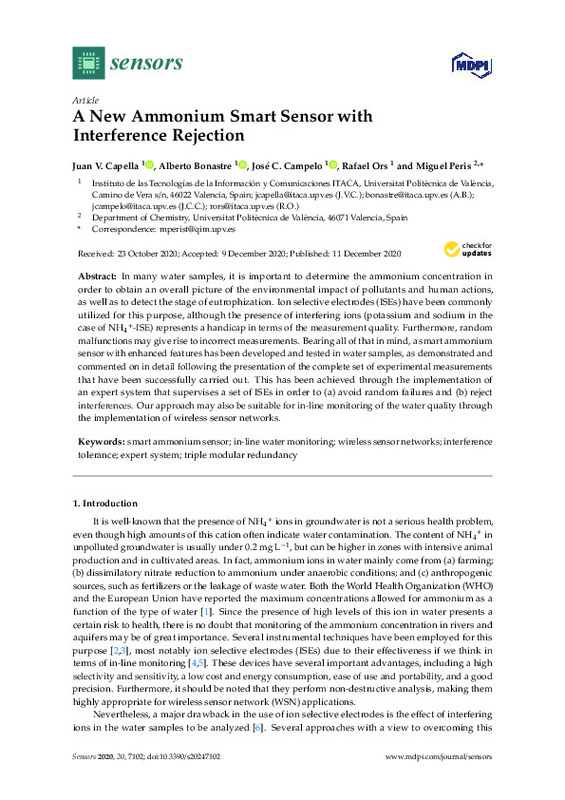Molins-Legua, C., Meseguer-Lloret, S., Moliner-Martinez, Y., & Campíns-Falcó, P. (2006). A guide for selecting the most appropriate method for ammonium determination in water analysis. TrAC Trends in Analytical Chemistry, 25(3), 282-290. doi:10.1016/j.trac.2005.12.002
Zhu, Y., Chen, J., Yuan, D., Yang, Z., Shi, X., Li, H., … Ran, L. (2019). Development of analytical methods for ammonium determination in seawater over the last two decades. TrAC Trends in Analytical Chemistry, 119, 115627. doi:10.1016/j.trac.2019.115627
Liu, J. (2020). New directions in sensor technology. TrAC Trends in Analytical Chemistry, 124, 115818. doi:10.1016/j.trac.2020.115818
[+]
Molins-Legua, C., Meseguer-Lloret, S., Moliner-Martinez, Y., & Campíns-Falcó, P. (2006). A guide for selecting the most appropriate method for ammonium determination in water analysis. TrAC Trends in Analytical Chemistry, 25(3), 282-290. doi:10.1016/j.trac.2005.12.002
Zhu, Y., Chen, J., Yuan, D., Yang, Z., Shi, X., Li, H., … Ran, L. (2019). Development of analytical methods for ammonium determination in seawater over the last two decades. TrAC Trends in Analytical Chemistry, 119, 115627. doi:10.1016/j.trac.2019.115627
Liu, J. (2020). New directions in sensor technology. TrAC Trends in Analytical Chemistry, 124, 115818. doi:10.1016/j.trac.2020.115818
Yaroshenko, I., Kirsanov, D., Marjanovic, M., Lieberzeit, P. A., Korostynska, O., Mason, A., … Legin, A. (2020). Real-Time Water Quality Monitoring with Chemical Sensors. Sensors, 20(12), 3432. doi:10.3390/s20123432
Martı́nez-Máñez, R., Soto, J., Garcia-Breijo, E., Gil, L., Ibáñez, J., & Llobet, E. (2005). An «electronic tongue» design for the qualitative analysis of natural waters. Sensors and Actuators B: Chemical, 104(2), 302-307. doi:10.1016/j.snb.2004.05.022
Legin, A. ., Rudnitskaya, A. ., Vlasov, Y. ., Di Natale, C., & D’Amico, A. (1999). The features of the electronic tongue in comparison with the characteristics of the discrete ion-selective sensors. Sensors and Actuators B: Chemical, 58(1-3), 464-468. doi:10.1016/s0925-4005(99)00127-6
Mueller, A. V., & Hemond, H. F. (2013). Extended artificial neural networks: Incorporation of a priori chemical knowledge enables use of ion selective electrodes for in-situ measurement of ions at environmentally relevant levels. Talanta, 117, 112-118. doi:10.1016/j.talanta.2013.08.045
Wen, Y., Mao, Y., Kang, Z., & Luo, Q. (2019). Application of an ammonium ion-selective electrode for the real-time measurement of ammonia nitrogen based on pH and temperature compensation. Measurement, 137, 98-101. doi:10.1016/j.measurement.2019.01.031
Handbook of Electrochemistry. (2007). doi:10.1016/b978-0-444-51958-0.x5000-9
Umezawa, Y., Bühlmann, P., Umezawa, K., Tohda, K., & Amemiya, S. (2000). Potentiometric Selectivity Coefficients of Ion-Selective Electrodes. Part I. Inorganic Cations (Technical Report). Pure and Applied Chemistry, 72(10), 1851-2082. doi:10.1351/pac200072101851
Capella, J. V., Bonastre, A., Ors, R., & Peris, M. (2015). An interference-tolerant nitrate smart sensor for Wireless Sensor Network applications. Sensors and Actuators B: Chemical, 213, 534-540. doi:10.1016/j.snb.2015.02.125
Choudhary, J., Balasubramanian, P., Varghese, D., Singh, D., & Maskell, D. (2019). Generalized Majority Voter Design Method for N-Modular Redundant Systems Used in Mission- and Safety-Critical Applications. Computers, 8(1), 10. doi:10.3390/computers8010010
Capella, J. V., Bonastre, A., Ors, R., & Peris, M. (2014). A step forward in the in-line river monitoring of nitrate by means of a wireless sensor network. Sensors and Actuators B: Chemical, 195, 396-403. doi:10.1016/j.snb.2014.01.039
Cuartero, M., Colozza, N., Fernández-Pérez, B. M., & Crespo, G. A. (2020). Why ammonium detection is particularly challenging but insightful with ionophore-based potentiometric sensors – an overview of the progress in the last 20 years. The Analyst, 145(9), 3188-3210. doi:10.1039/d0an00327a
Bembe, M., Abu-Mahfouz, A., Masonta, M., & Ngqondi, T. (2019). A survey on low-power wide area networks for IoT applications. Telecommunication Systems, 71(2), 249-274. doi:10.1007/s11235-019-00557-9
Freiser, H. (Ed.). (1980). Ion-Selective Electrodes in Analytical Chemistry. doi:10.1007/978-1-4684-3776-8
Peris, M., Bonastre, A., & Ors, R. (1998). Distributed expert system for the monitoring and control of chemical processes. Laboratory Robotics and Automation, 10(3), 163-168. doi:10.1002/(sici)1098-2728(1998)10:3<163::aid-lra6>3.0.co;2-2
Carminati, M., Turolla, A., Mezzera, L., Di Mauro, M., Tizzoni, M., Pani, G., … Antonelli, M. (2020). A Self-Powered Wireless Water Quality Sensing Network Enabling Smart Monitoring of Biological and Chemical Stability in Supply Systems. Sensors, 20(4), 1125. doi:10.3390/s20041125
Nakas, C., Kandris, D., & Visvardis, G. (2020). Energy Efficient Routing in Wireless Sensor Networks: A Comprehensive Survey. Algorithms, 13(3), 72. doi:10.3390/a13030072
Capella, J. V., Bonastre, A., Campelo, J. C., Ors, R., & Peris, M. (2020). IoT & environmental analytical chemistry: Towards a profitable symbiosis. Trends in Environmental Analytical Chemistry, 27, e00095. doi:10.1016/j.teac.2020.e00095
Pretsch, E. (2007). The new wave of ion-selective electrodes. TrAC Trends in Analytical Chemistry, 26(1), 46-51. doi:10.1016/j.trac.2006.10.006
STM Microelectronics https://www.st.com/content/st_com/en/products/microcontrollers-microprocessors/stm32-32-bit-arm-cortex-mcus/stm32-ultra-low-power-mcus/stm32l4-series/stm32l4x2/stm32l422cb.html
Analog Devices https://www.analog.com/media/en/technical-documentation/data-sheets/AD524.pdf
Capella, J. V., Bonastre, A., Ors, R., & Peris, M. (2010). A Wireless Sensor Network approach for distributed in-line chemical analysis of water. Talanta, 80(5), 1789-1798. doi:10.1016/j.talanta.2009.10.025
Bonastre, A., Capella, J. V., Ors, R., & Peris, M. (2012). In-line monitoring of chemical-analysis processes using Wireless Sensor Networks. TrAC Trends in Analytical Chemistry, 34, 111-125. doi:10.1016/j.trac.2011.11.009
Mei-Chen Hsueh, Tsai, T. K., & Iyer, R. K. (1997). Fault injection techniques and tools. Computer, 30(4), 75-82. doi:10.1109/2.585157
[-]









